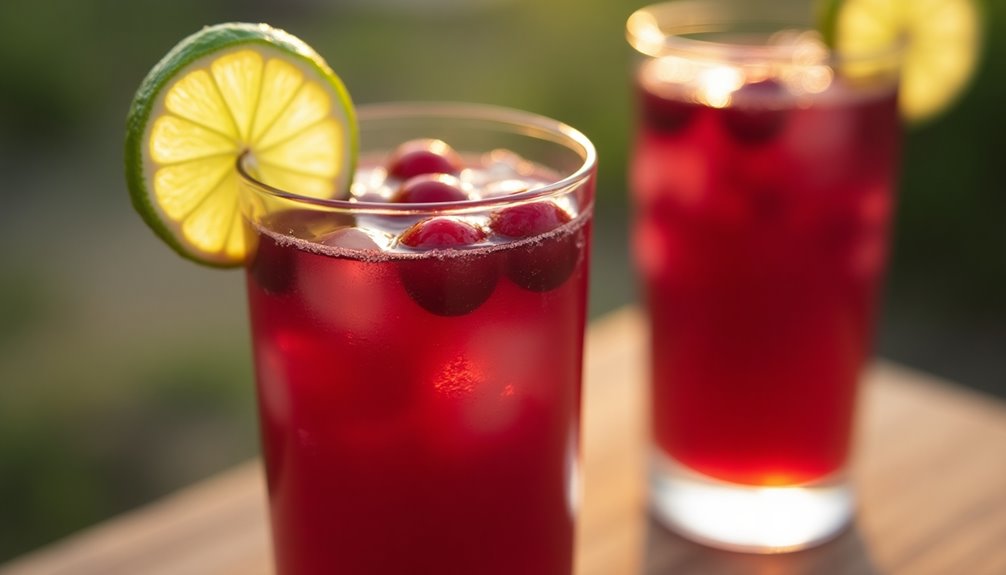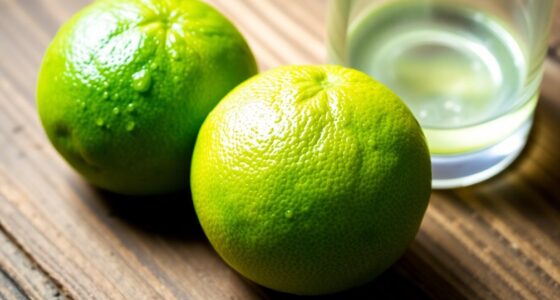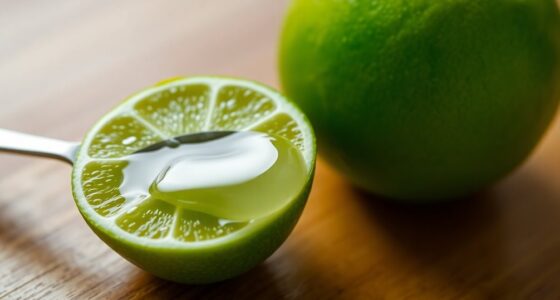Cranberry juice contains about 30.87 grams of carbohydrates per cup, with roughly 30.61 grams coming from sugars. Most of the calories in cranberry juice, around 116 per serving, are from carbohydrates. Since it has minimal fiber—only about 0.25 grams—it's important to consider how it fits into your overall diet. Keeping an eye on your daily carb intake can help you stay on track with your health goals. There's more to discover about its benefits and limitations.
Key Takeaways
- One cup of unsweetened cranberry juice contains approximately 30.87 grams of carbohydrates.
- Out of the total carbs, about 30.61 grams are sugars.
- A typical serving of cranberry juice provides around 116 calories, primarily from carbohydrates.
- The daily recommended carbohydrate intake for adults is between 225 to 325 grams.
- Regular consumption of cranberry juice can significantly contribute to daily carbohydrate totals.

Have you ever wondered how many carbs are in cranberry juice? If you've enjoyed a refreshing glass, you might be curious about its nutritional profile, especially when it comes to carbohydrates. One cup of unsweetened cranberry juice contains approximately 30.87 grams of carbohydrates. That's a significant amount, especially if you're monitoring your carb intake for health or dietary reasons.
Most of the carbohydrate content in cranberry juice comes from sugars. In fact, about 30.61 grams of that carbohydrate total are sugars. So, when you sip on a cup of cranberry juice, you're mainly consuming sugars, which provide a quick source of energy. The high sugar content is something to keep in mind, especially if you're watching your sugar consumption. Given that cranberry juice is predominantly made up of carbohydrates, around 95% of its calories come from this macronutrient. This means if you're counting calories, you should pay special attention to the carbohydrate content.
You might be surprised to learn that while cranberry juice packs a decent amount of carbs, it has minimal dietary fiber. A typical cup of cranberry juice contains only about 0.25 grams of dietary fiber. This lack of fiber means that cranberry juice won't help you feel full for long, and you won't get the same benefits as you'd from whole fruits, which are typically richer in fiber. So, if you're looking to increase your fiber intake, you might want to pair your juice with some whole cranberries or other fiber-rich foods.
When you consider the caloric content, a typical serving of cranberry juice provides around 116 calories. Those calories primarily come from carbohydrates, making it essential to factor this into your daily caloric intake if you're monitoring weight or overall nutrition. If you're aiming for a balanced diet, think about how cranberry juice fits into your daily calorie and carb limits, especially if you enjoy it regularly.
Now, if you're keeping track of your Daily Value (DV) for carbohydrates, it's important to note that the daily recommended intake varies based on individual dietary needs. Generally speaking, the average adult's daily carbohydrate intake should be around 225 to 325 grams, depending on their total calorie needs.
With a cup of cranberry juice containing just over 30 grams, it can be a significant addition, especially if you enjoy multiple servings throughout the day.
Frequently Asked Questions
Is Cranberry Juice Good for a Low Carb Diet?
Cranberry juice isn't ideal for a low carb diet due to its high sugar content. If you're watching your carb intake, you might want to limit or avoid it altogether.
However, if you enjoy the flavor, consider unsweetened options or smaller portions to keep carbs in check.
How Many Carbs Are in an 8 Oz Glass of Cranberry Juice?
Imagine a vibrant tapestry woven with rich, sweet threads. When you pour an 8 oz glass of cranberry juice, you’re looking at about 30. 87 grams of carbohydrates. As you savor each sip, the burst of flavor dances across your palate, enveloping you in a refreshing experience. But while you enjoy this delicious drink, you might wonder how many carbs are in V8, as you navigate your choices for a balanced diet. Each option has its own unique profile, making it essential to be mindful of your carbohydrate intake.
Most of that sweetness, around 30.61 grams, comes from sugars, making it a flavorful indulgence. This juice, while delicious, holds minimal dietary fiber—just 0.25 grams.
How Many Carbs Are in 1/2 Cup of Cranberry Juice?
When you pour yourself half a cup of cranberry juice, you're consuming about 15.43 grams of carbohydrates.
Most of these carbs come from sugars, totaling around 15.3 grams per serving.
Keep in mind that cranberry juice doesn't provide much dietary fiber—less than 0.125 grams.
If you're watching your carbohydrate intake or sugar levels, this is essential information to consider for your dietary choices and overall health.
How Many Carbs Are in Ocean Spray Cranberry Juice?
Did you know that Ocean Spray Cranberry Juice packs about 31 grams of carbohydrates in just an 8 fl oz serving?
When you check the label, you'll see that nearly all of that's sugar—around 30 grams!
With only 0.3 grams of fiber, it's not your best choice for that.
However, it's cholesterol-free and a great source of vitamin C, giving you 119% of your Daily Value in one serving.
Conclusion
In the world of beverages, you often hear, "You are what you drink." When it comes to cranberry juice, understanding its carb content can help you make healthier choices. While it's packed with vitamins and antioxidants, keep an eye on those carbs, especially if you're monitoring your intake. Enjoy it in moderation, and remember that balance is key to a healthy diet. So go ahead, sip wisely and relish the benefits of this tart delight!
Cindy thoroughly researches juicing trends, techniques, and recipes to provide readers with practical advice and inspiration. Her writing style is accessible, engaging, and designed to make complex concepts easy to understand. Cindy’s dedication to promoting the advantages of juicing shines through her work, empowering readers to make positive changes in their lives through the simple act of juicing.
















